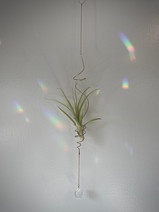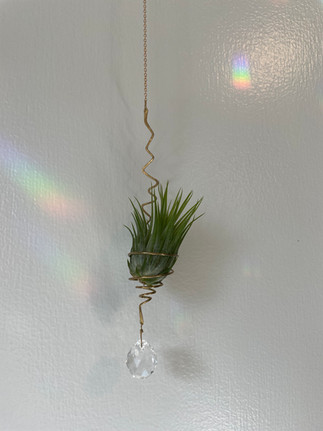Tillandsias "Air Plant" CARE
- ramblinsoulstudios
- Jan 11, 2024
- 4 min read
Updated: Feb 6

Tillandsias get their more common name, air plant, because they grow without soil in the air.
They are native to the forests, mountains and deserts of Central and South America, the southern United States and the West Indies. They normally grow while attached to other plants and rocks, clinging onto them with their roots. Air plants are epiphytic, meaning they absorb moisture and nutrients through their leaves, while the roots are used primarily to provide support for the plant. Moisture and nutrients are gathered from the air (dust, decaying leaves and insect matter) through structures on the leaves called trichomes (modified scales and hairs). They need to absorb moisture consistently. This either comes from very high humidity (as in a greenhouse) or from regular soaking.
HOW TO WATER
Do all watering in the morning. Evening soaking or misting disrupts the plants ability to respire overnight, and extends drying time.
Some people swear by misting, others by soaking, and still others use a combination. My preferred method is to soak.
To give your air plant a bath, carefully remove it from wherever you have it displayed and set it in a bowl that is large enough to submerge the plant in water. Leave them in the bath for 10 minutes to one hour depending on your plants needs.
Remove plant from water and shake it upside-down to get rid of any excess water that may be pooling at the base of the inner leaves. Then, place your air plant upside down on a towel and place it in a bright spot. Let it sit for one to three hours, depending on when it is fully dry. Ensure there is no water pooled or else your air plant may rot.
Return your air plants to their regular spot until it is time to bathe again.

FREQUENCY
Typically, in the summer they need a weekly soak, whereas in the winter it’s once every 3 weeks or so.
The needs of the plant vary dramatically with the space in which it is placed, so evaluate your plants needs carefully. How much light is your plant receiving? What is the temperature in your home at this particular time of year? Is the space very dry (is your plant near a heater or fireplace?) Or is it very humid?
Pay attention to the changing of the seasons and the health of your air plant and water accordingly. The hotter and dryer the air, the more you need to water. The cooler and more humid the air, the less water your air plant will need.
A sunny bathroom or active kitchen makes a happy home for an air plant, because the humidity from your shower or boiling water will take care of most plant misting for you. However, keep in mind that the more humidity in the air will cause your brass sun catcher to oxidize faster.
WHAT WATER TO USE
Make sure water is room temperature.
I like to use rainwater whenever I can. You can also use filtered water or if unavailable, tap water will do. Just leave it out for 24 hours to allow the chlorine to evaporate.
LIGHT
Bright, indirect light with up to 1-3 hours of direct sun in the early or late part of the day is ideal. Too little light causes characteristics of discoloration of plant leaves, all over fading, or leaves falling apart during watering or handling. Too much light can result in browning (burnt) leaves. The higher the humidity in your space, the more light is tolerated by the air plant.
TEMPERATURE
Normal room temperatures are adequate. They do best between 50-90 degrees F. Always keep them above 40ᵒF.
TROUBLESHOOTING
Is your air plant looking dull, a bit brown, or limp? This is usually because of under watering!
Too little water results in deeply channeled leaves that curve inward on themselves and browning at the tip.
Too much water leads to rot.
Signs of over-watering, are tricky to undo. If the air plant is rapidly losing leaves and the base has turned black or brown, the air plant has gone rotten. Resist watering and cross your fingers!
If the tips of your air plant are turning brown, try using rainwater or unchlorinated water as described above. If you are not giving them chlorine but they are still turning brown, then your plant may not be getting enough water.
Remove any dead exterior leaves by gently pulling them off. The plant should stay intact and the inside leaves should be green and healthy-looking.
LIFECYCLE AND BLOOM
Tillandsias will only bloom once in their life. Flowering is the peak of the air plant life cycle, but also marks the beginning of the plant’s old age - after it flowers, the plant will eventually die.But before it does the mother plant will start producing 2-8 baby plants (or pups). This will happen just before, during or after flowering. These baby air plants, which start out very small, will eventually grow into their own mother plants. Pups can safely be separated from the mother plant when they’re about ⅓-½ the size of the original plant. Careful not to remove them too early, as they’re actually receiving nutrients from the mother air plant!
Blooms can last from days to months, depending on the species.
To promote blooms give your plant the maximum allowable light with sufficient water and fertilizer. Be patient as they are slow to mature to bloom size. Follow the care procedures closely and add a bit of orchid / Bromeliad fertilizer once a month in the bath to help move along the life cycle.
When the blooms start to show, keep them out of the water. You can still give your air plant a bath, but the delicate petals won’t last submerged in water.


























































Comments